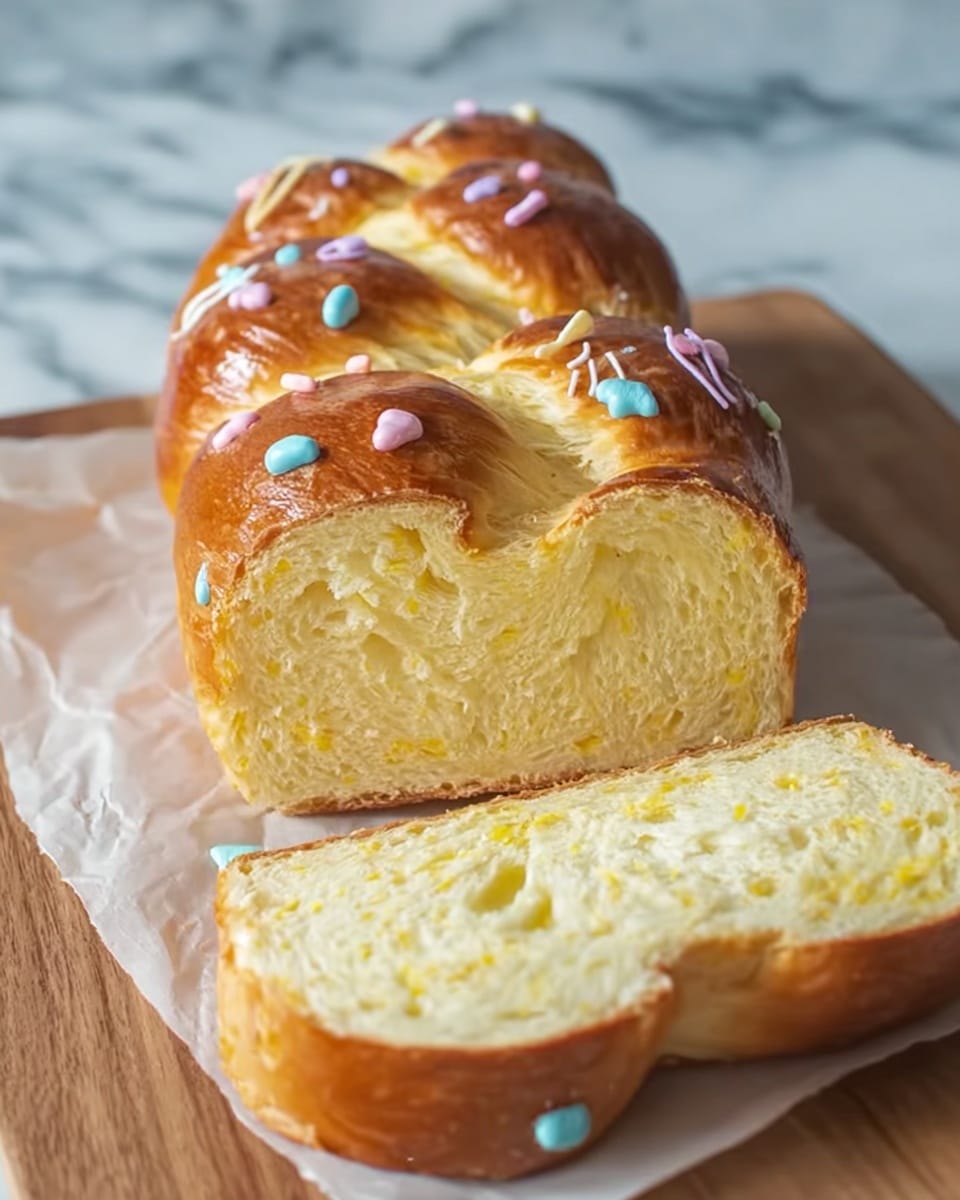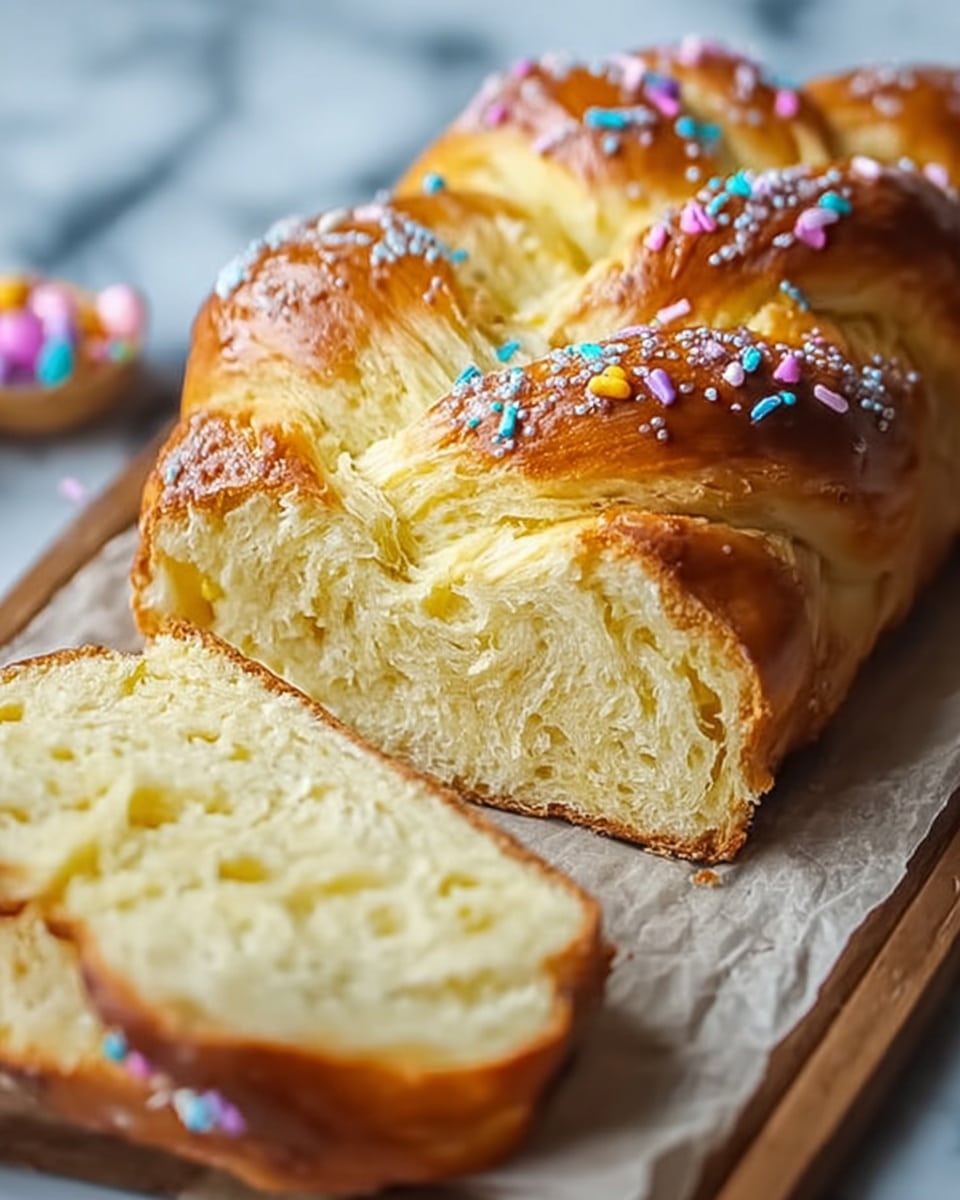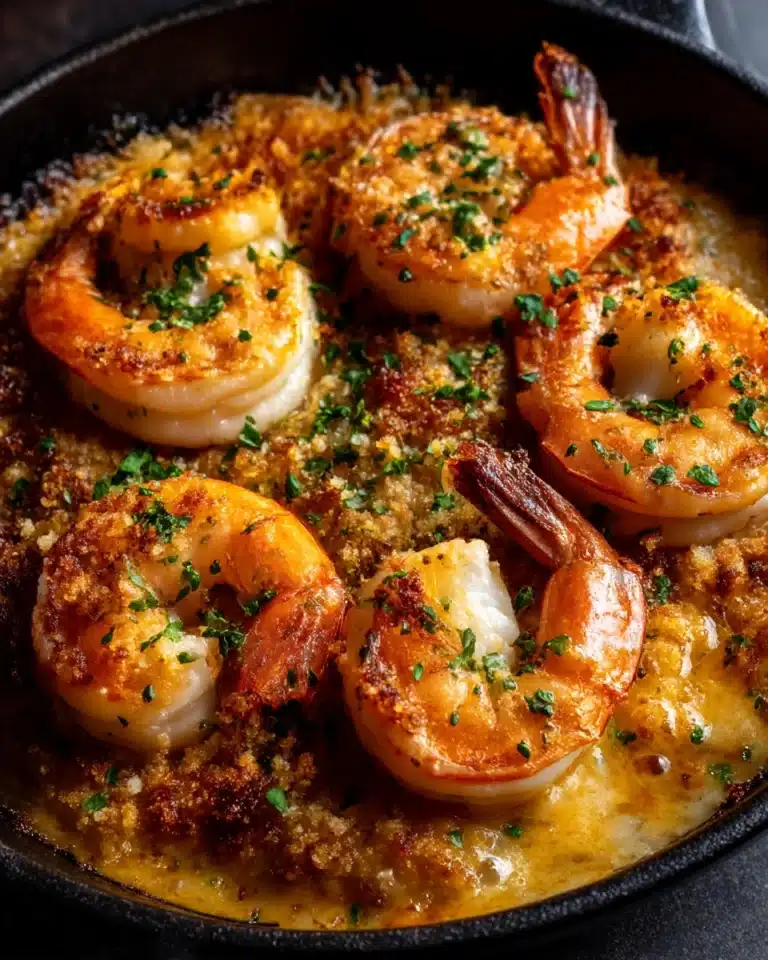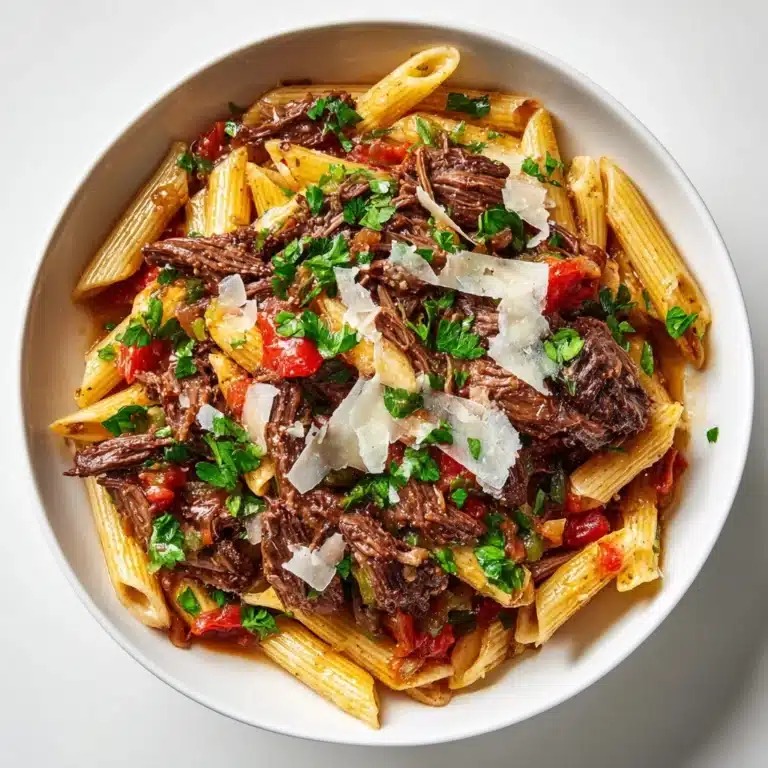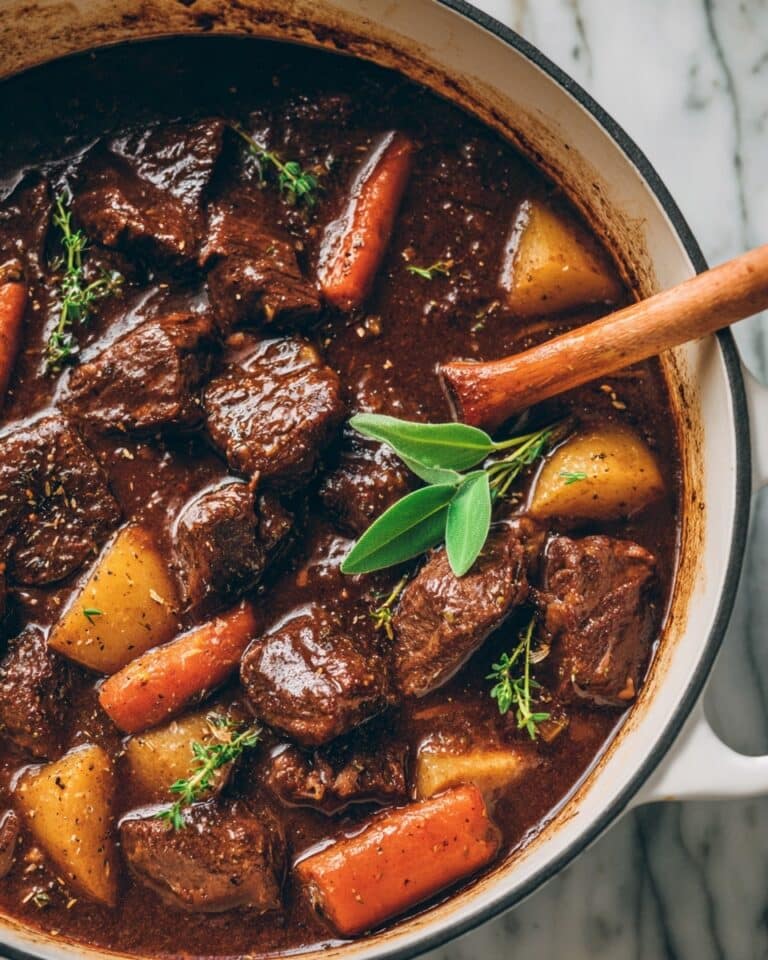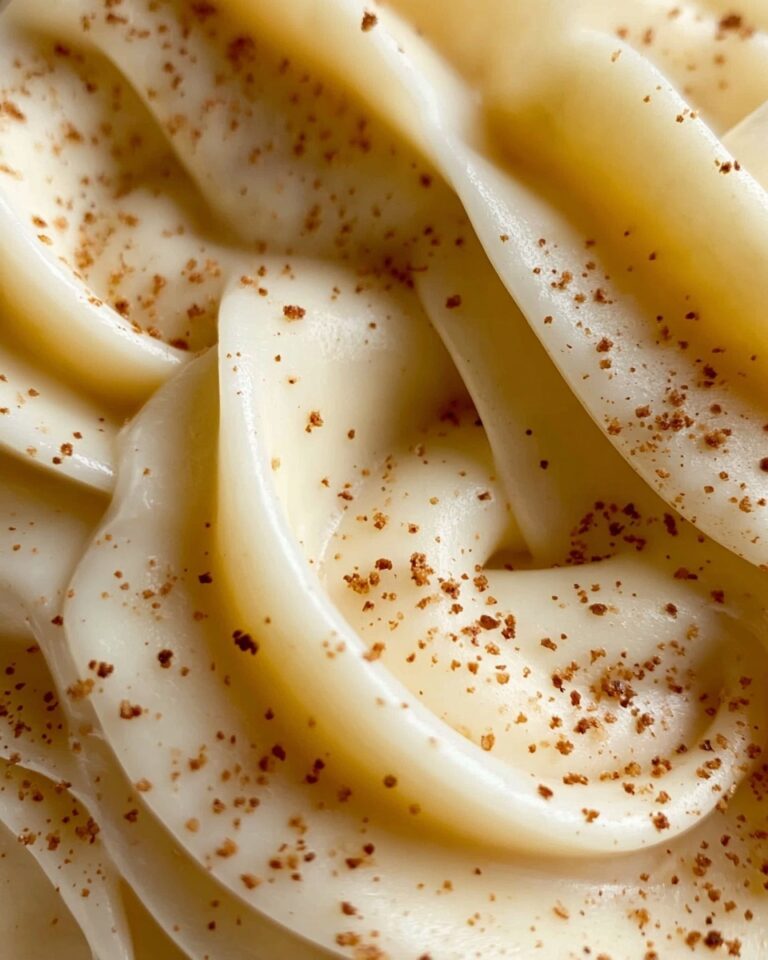The Italian Ricotta Easter Bread Recipe is an absolute celebration of spring’s sweetest traditions, blending the tender richness of ricotta cheese with the gentle sweetness of a braided yeast bread. This beautiful loaf, often adorned with colorful dyed eggs and festive sprinkles, carries with it a warm heritage perfect for sharing at any Easter gathering. Soft, moist, and subtly flavored with vanilla and a touch of cinnamon, this bread is more than just a treat—it’s a joyful ritual that brings family and friends closer with every bite.
Ingredients You’ll Need
The magic of this Italian Ricotta Easter Bread Recipe lies in its simple yet thoughtful ingredients. Each one brings essential texture, flavor, and that unmistakable golden color that makes the bread glow with warmth.
- 4 cups all-purpose flour: The sturdy base that gives the bread its structure and softness.
- 1 package (or 2 ¼ tsp) active dry yeast: This awakens the dough, helping it rise into a light, airy loaf.
- 1 cup whole milk, warmed: Provides moisture and a tender crumb, helping the yeast activate smoothly.
- 1 cup ricotta cheese, drained: Adds creaminess and richness that make the bread irresistibly soft.
- 1/2 cup granulated sugar: Just the right amount to bring sweetness without overpowering.
- 1/4 cup unsalted butter, melted: Contributes a luscious texture and buttery flavor.
- 2 large eggs: Bind the dough together and add natural richness.
- 1 tsp vanilla extract: Infuses a delicate aromatic note that makes the bread smell like comfort.
- 1/2 tsp salt: Balances the sweetness and enhances all the other flavors.
- 1/2 tsp ground cinnamon (optional): Offers a hint of warm spice, perfectly subtle for springtime.
- 1 egg (for egg wash): Ensures a shiny, golden crust that’s absolutely enticing.
- Sprinkles or colored sugar (optional): Adds fun, festive color and extra sweetness on top.
- 2-4 dyed Easter eggs (optional, for decoration): Embodies tradition and adds charming visual appeal.
How to Make Italian Ricotta Easter Bread Recipe
Step 1: Preparing the Dough
Start by waking up your yeast with warm milk and a little sugar. Let it get foamy and lively—that’s your bread’s secret to rising beautifully. Meanwhile, mix the flour, sugar, salt, and optional cinnamon in a large bowl. Then add in the rich ricotta, melted butter, eggs, and vanilla. Combine everything with the yeast mixture to create a sticky but manageable dough. Knead on a floured surface for about 10 minutes until smooth and elastic. This kneading is essential because it develops the gluten, giving your bread that perfect chewy softness.
Step 2: Shaping the Bread
Once your dough has doubled in size, punch it gently to release the air. Divide it into three equal parts and roll each into long ropes about 18 to 20 inches long. This is where the artistry begins—braid your ropes together carefully, creating that classic Easter bread look. If you like tradition, carefully tuck brightly dyed Easter eggs into the braids; these not only add beautiful color but also honor the classic Italian celebration. Place your braided loaf on a baking sheet lined with parchment to prevent sticking and make cleanup easy.
Step 3: Second Rise
Cover your bread with a clean towel and let it rest in a warm spot for another 30 minutes to an hour. This second rise plumps up the dough and ensures your loaf will bake light and fluffy. Patience here truly pays off—the longer the rise, the softer and airier your bread will be.
Step 4: Baking to Perfection
Preheat your oven to a toasty 350°F (175°C). Brush the entire loaf with beaten egg, which will give it that signature golden glow and a slight crunch on the crust. Bake for 30 to 35 minutes, watching as the bread transforms into a beautifully browned masterpiece. You’ll know it’s done when tapping on the bottom sounds hollow—a classic test for perfect bread.
Step 5: Cooling and Decorating
Once out of the oven, give your bread a chance to cool on a wire rack. This prevents sogginess and locks in the soft texture. If you want to add a bit more fun and whimsy, sprinkle colorful sugar or festive sprinkles on top while the bread is still slightly warm. Then, slice into it and enjoy the moist, delicate crumb in every mouthful. This Italian Ricotta Easter Bread Recipe truly shines as a centerpiece on your holiday table.
How to Serve Italian Ricotta Easter Bread Recipe
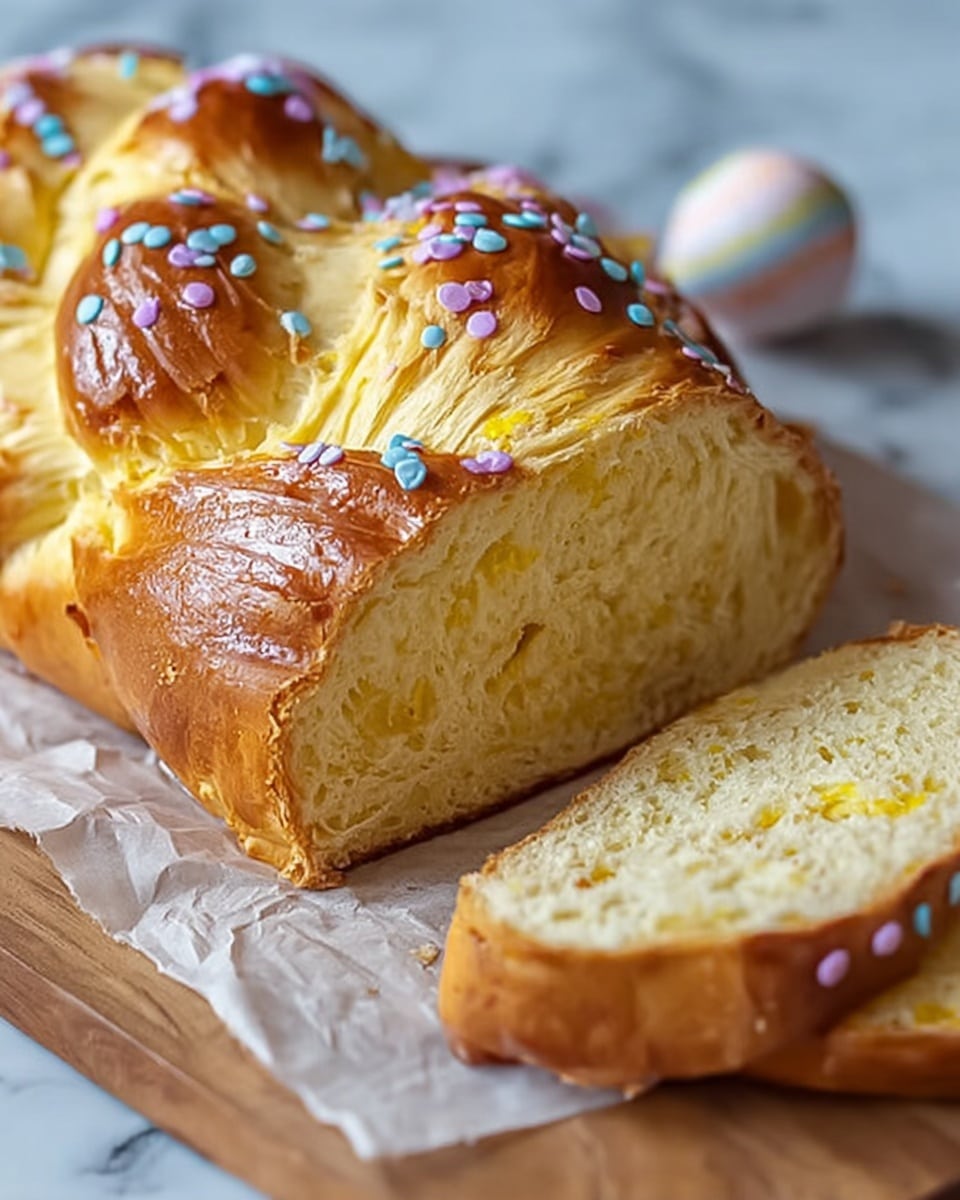
Garnishes
Simple garnishes like a dusting of powdered sugar or a light glaze of honey set off the subtle sweetness and add a little sparkle. Fresh herbs like mint or small edible flowers can also bring an elegant touch if you want to elevate your presentation for a festive first impression.
Side Dishes
This bread pairs wonderfully with a variety of springtime and brunch favorites. Think creamy ricotta spread, fresh berry compote, or a side of honey butter. For savory contrasts, serve alongside sharp cheeses or cured meats, making your gathering feel luxuriously indulgent.
Creative Ways to Present
You can nestle the bread alongside a bright spring bouquet or place it in a rustic basket lined with a colorful cloth for a charming farmhouse vibe. Arrange slices on a large platter with fresh fruit and nuts for a brunch buffet that invites guests to indulge and share stories. The festive dyed eggs tucked in the braid add that perfect conversation starter for any Easter celebration.
Make Ahead and Storage
Storing Leftovers
Wrap the bread tightly in plastic wrap or place it in an airtight container at room temperature to keep it soft and fresh for up to three days. Be sure to keep it away from heat sources to prevent it from drying out.
Freezing
If you want to enjoy this Italian Ricotta Easter Bread Recipe later, freezing is a great option. Wrap the completely cooled bread tightly in plastic wrap and then foil, or place it in a freezer-safe bag. It will keep well for up to two months. When you’re ready, thaw it overnight at room temperature.
Reheating
To refresh the bread’s soft texture and warm flavors, reheat slices gently in a toaster oven or wrapped in foil in a warm oven at 300°F for 10-15 minutes. Avoid microwaving, which can make the bread rubbery or dry.
FAQs
Can I use part-skim ricotta instead of whole milk ricotta?
Yes, part-skim ricotta can work, though whole milk ricotta offers a creamier texture that enriches the bread more profoundly. If using part-skim, your bread might be slightly less moist but still delicious.
Do I need to dye the eggs for decoration?
Not at all! While traditional and visually charming, the dyed eggs are optional. You can also skip them or use faux decorative eggs if you prefer to keep things edible and simple.
Can I make this bread dairy-free?
This recipe relies heavily on ricotta and butter for its signature taste and texture, so a fully dairy-free version would require substitutions that might change the result. However, you could try using dairy-free cream cheese and plant-based butter for an experiment, but the texture and flavor will be different.
How long does the dough take to rise?
The first rise usually takes about 1 to 1.5 hours until doubled in size, and the second rise after braiding should be 30 to 60 minutes until puffy. Warm and humid environments speed up rising, while cooler kitchens might take longer.
Can I add other flavors to the dough?
Absolutely! Some people like adding orange zest or anise extract for a fragrant twist. Just be careful not to add too much liquid or overpower the subtle ricotta flavor that makes this bread so special.
Final Thoughts
This Italian Ricotta Easter Bread Recipe is a treasured slice of tradition baked into a soft, sweet, and stunning loaf that’s well worth every minute of your effort. Whether you’re sharing it with family or gifting it to friends, it’s a heartfelt way to celebrate spring and bring joy to your table. Give it a try, and you just might find yourself making this beautiful bread part of your yearly ritual too!
Print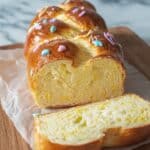
Italian Ricotta Easter Bread Recipe
- Prep Time: 20 minutes
- Cook Time: 35 minutes
- Total Time: 2 hours 30 minutes
- Yield: 1 loaf (serves about 8)
- Category: Bread
- Method: Baking
- Cuisine: Italian
Description
This Italian Ricotta Easter Bread is a traditional sweet yeast bread enriched with creamy ricotta cheese, eggs, and butter, braided beautifully and sometimes adorned with colorful Easter eggs. Soft, slightly sweet, and fragrant with vanilla and cinnamon, this festive bread makes a perfect centerpiece for your Easter celebration or any springtime gathering.
Ingredients
Dough Ingredients
- 4 cups all-purpose flour
- 1 package (or 2 ¼ tsp) active dry yeast
- 1 cup whole milk, warmed
- 1 cup ricotta cheese, drained
- ½ cup granulated sugar
- ¼ cup unsalted butter, melted
- 2 large eggs
- 1 tsp vanilla extract
- ½ tsp salt
- ½ tsp ground cinnamon (optional)
For Egg Wash and Decoration
- 1 egg (for egg wash)
- Sprinkles or colored sugar (optional)
- 2–4 dyed Easter eggs (optional, for decoration)
Instructions
- Prepare the Dough: In a small bowl, mix warm milk, yeast, and 1 tablespoon of sugar. Let it sit for 5-10 minutes until foamy, indicating the yeast is active. In a large bowl, combine flour, remaining sugar, salt, and optional cinnamon. Add ricotta, melted butter, eggs, vanilla extract, and the yeast mixture. Stir to form a dough, then knead on a floured surface for 8-10 minutes until smooth and elastic. Place the dough into a greased bowl, cover it with a damp towel, and let it rise in a warm place for 1 to 1.5 hours until doubled in size.
- Shape the Bread: Punch down the risen dough and divide it into three equal parts. Roll each piece into long ropes about 18-20 inches in length. Braid the three ropes together to form a loaf. If desired, nestle dyed Easter eggs into the braids as decoration. Place the braided dough on a parchment-lined baking sheet.
- Second Rise: Cover the braided loaf with a towel and allow it to rise for an additional 30 minutes to 1 hour until puffy.
- Bake the Bread: Preheat the oven to 350°F (175°C). Brush the loaf with a beaten egg to achieve a golden, glossy finish. Bake the bread for 30-35 minutes until golden brown and hollow-sounding when tapped on the bottom.
- Cool and Decorate: Remove the bread from the oven and cool it on a wire rack. Optionally, sprinkle with colorful sugar or sprinkles to enhance its festive appearance. Serve warm or at room temperature and enjoy the soft, rich flavors of this traditional Italian Easter bread.
Notes
- Make sure the milk is warm but not hot to avoid killing the yeast.
- Draining the ricotta well prevents the dough from becoming too wet.
- For best results, knead the dough until it feels smooth and elastic, as under-kneaded dough can result in a dense bread.
- Using dyed Easter eggs is purely decorative and optional; ensure eggs are hard-boiled before embedding in the dough.
- The bread can be stored in an airtight container for 2-3 days or frozen for longer storage.

